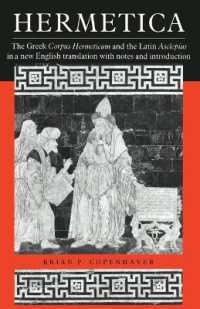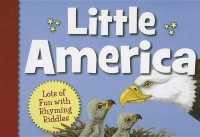- ホーム
- > 洋書
- > 英文書
- > History / World
Full Description
The 2016 referendum on Brexit represents a watershed moment in the United Kingdom's contemporary history, reflecting new divides and questioning many of the premises on which the country's identity and position in the world had been based for almost half a century.
From Cool Britannia to Brexit discusses and analyses the last three decades of British political history, looking at why Britain found itself shut out from its immediate neighbours on the continent in 2016, twenty years after the country was celebrated as a prosperous, optimistic and culturally influential "Cool Britannia". This book ultimately shows the limits of the Westminster model of government and the enduring inequalities that affect Britain but also insists on the resilience of its state and institutions.
This book is primarily aimed at an undergraduate and non-specialist audience. It explores the long-term political, economic and social changes which have affected the British polity in the early 21st century, which led to a dramatic decision in 2016, which in turn created more instability and political turbulence.
Contents
Introduction
Chapter 1: The Constitution
Introduction
Political parties and constitutional reforms
Reforming Britain's constitution
The House of Lords
The Supreme Court
Fixed-term Parliaments
Electoral reform
The Brexit referendum: a challenge to parliamentary democracy
The Covid-19 crisis and the constitution
Constitutional Monarchy at the end of the second Elizabethan era
The monarch's political neutrality in question
The monarch's religious role in an increasingly secular Britain
Conclusion
Chapter 2: Parties, Elections and Voters
Introduction
1. The new party system(s)
2. The crisis of representation: how voting changed
3. Changes in parties: policies and organisation
4. New forms of participation
Petitions and consultations
Online campaigning
Deliberative democracy
Social movements
Conclusion
Chapter 3: The State of the Union
Introduction
1. Devolution to Scotland and Wales
2. Northern Ireland
3. The 2014 Scottish independence referendum
4. The Brexit effect
5. Consequences of the Covid pandemic
6. The state of England
Conclusion
Chapter 4: Britain and Europe - The Road to Brexit
Introduction
1. The ambiguities of New Labour
Changes in rhetoric
Limits to the changes
2. The rise of Euroscepticism
The Conservative party in opposition
The coalition government
3. The Brexit referendum
The campaign
Explaining the result
4. UK-EU relations after Brexit
Conclusion
Chapter 5: Britain in the World
Introduction
New Labour, old values ?
The UK, NATO and the defence of Europe in the post-Cold War context
The Franco-British Saint-Malo Declaration: introducing new concepts in European defence
Liberal interventionism and the 'special relationship' with the USA
The war in Kosovo and the UK's 'moral' international role
Reviving the 'special relationship' in the 'war on terror'
The legacy of 'Blair's wars' and 'liberal conservatism'
The 'Arab Spring' and its aftermath
No 'strategic shrinkage': reviewing the UK's defence and security priorities
The United Kingdom and the EU's foreign and security policy
'Global Britain': a redefinition of Britain's role in the world?
Conclusion
Chapter 6: The Economy
Introduction
1. The New Labour era
The 1997 economic context
New Labour's proposals for the 1997 general election
Institutional reform: the independence of the Bank of England
Globalisation: a catalyst for growth
Public spending and investment
Tax policy and welfare reforms
The Housing market boom
2. Gordon Brown's premiership and the aftermath of the 2008 global financial crisis
The global financial crisis and its impact on the British economy
Economic measures
Oucomes and the Brown's legacy
3. The Conservative-led coalition government (2010-2015) and the Conservative government before the 2016 referendum
Austerity policies
Financial regulation and banking policies
Monetary policies and interest rates
Taxation policies
Labour market and employment policies
Housing and infrastructure policies
4. What political response to economic challenges after 2016?
Trade policy and agreements
Monetary policy and the control of inflation
Regulatory reforms and financial services
Fiscal policy and public spending
Investment and productivity challenges
Labour market and immigration policies
Conclusion
Chapter 7: A more diverse and unequal society
Introduction
1. Demographic trends
Population and families
Social attitudes
2. Immigration and multiculturalism
Attitudes towards immigrants
Questioning state multiculturalism
Immigration policy
3. Class and social inequalities
Social classes and identity
4. Inequalities, poverty and unemployment
Poverty
Unemployment
Public attitudes to poverty and welfare
Social policies since 1997
5. The housing crisis
Conclusion
Chapter 8: Education
Introduction
1. New Labour's education agenda
Early years and primary education
Secondary education
Higher education
2. Education policy and reforms under the Coalition Government
Academisation and free schools
Curriculum and assessment reforms
Teacher training and professional development
Higher education reforms
3. New challenges: education policy in the aftermath of Brexit and Covid-19
School reforms
The crisis of higher education
Cyber security and artificial intelligence in education
Conclusion
Chapter 9: Old and New Media
Introduction
The evolution of traditional media: the press, television and the radio
The press: decline and digital transition
Television: innovation and cultural change
The digital switch-over
The changing role of the BBC and public service broadcasting
The end of impartiality: opinion channels
The rise of reality TV and entertainment formats
The streaming revolution and global competition
Radio: challenges and adaptation
Digital transformation
Commercial consolidation
Community radio
Changing listening habits
Scandals and ethics
The rise of tabloid culture and ethical challenge
The phone hacking scandal and the Leveson Inquiry
Coverage of terrorism and minority representation
Covering the royal family
The 2016 referendum campaign
Media impartiality and the challenge of 'false balance': the case of the BBC
A digital battleground
Conclusion
Chapter 10: Cultural policy
Introduction
1. The New Labour vision: Cool Britannia ?
2. The impact of austerity on the cultural sector
3. Two shocks: Brexit and Covid
4. The legacy of empire and culture wars
Conclusion








